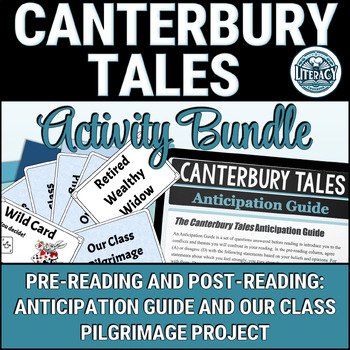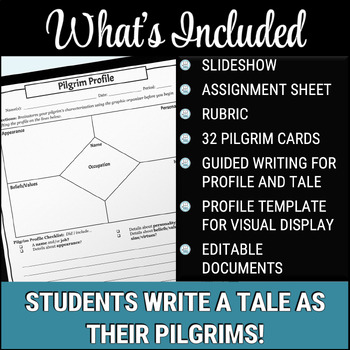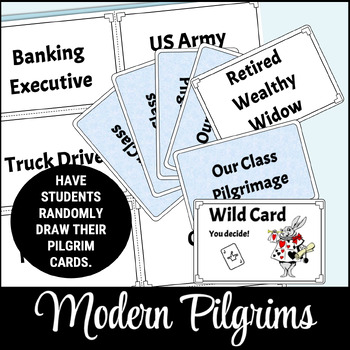Canterbury Tales Bundle - Pre-Reading and Creative Pilgrim Project - PDF Version
- Zip
- Google Apps™
- Easel Activity
- Easel Assessment

What educators are saying
Products in this Bundle (2)
Description
My two most popular Canterbury Tales products: Anticipation Guide for pre-reading and a Final Project! I also included a BONUS chart for students to take notes on the various pilgrims while reading the Prologue.
Anticipation Guide:
This is a pre-reading activity to use before beginning Geoffrey Chaucer's The Canterbury Tales with students.
Student Directions: An Anticipation Guide is a set of questions answered before reading to introduce you to the conflicts and themes you will confront in your reading. In the pre-reading column, agree or disagree with the following statements based on your beliefs and opinions. There are no right or wrong answers here—this serves to stimulate your thinking as you begin reading the work. After reading, you will determine if the work itself supports or refutes the statements below. You will use textual evidence (line or page #’s) to prove this.
For Teacher Use: This anticipation guide references themes and concepts that lie within the text of the work; this helps to motivate students to make meaning for themselves and connect with the text before and after reading. The bottom of the guide asks students to choose a statement they feel strongly about in order to consider both sides of an argument on the issue.
Teacher Feedback on My Anticipation Guides:
⭐⭐⭐⭐⭐ 5.0
A really great way to start the play. Students loved discussing the ideas
⭐⭐⭐⭐⭐ 5.0
Great anticipation guide questions! I had the kids answer them for homework and then in class I had them move to one side of the room or the other for "agree" or "disagree" and then they debated on each statement.
⭐⭐⭐⭐⭐ 5.0
My students enjoyed the discussion that this activity allowed. They were extremely engaged. I will go back to it to finish when we read the end of the book.
⭐⭐⭐⭐⭐ 5.0
This was exactly what I was looking for. Thanks!
⭐⭐⭐⭐⭐ 5.0
Love using these types of activities to start a unit with my students. Thanks!
Pilgrimage Project:
Suggested Teacher Instructions:
I designed this project as a culminating, summative assessment after reading Chaucer’s Canterbury Tales for English 4; however, the project is adaptable for a journey-themed unit or a poetry unit.
Anticipatory Set: I begin by showing students the Canterbury Pilgrim’s journey map from London to the Canterbury Cathedral, and I find a local historical landmark that is approximately the same distance from our school. Using Google Maps, I show them the journey we will take under the same premise as the Canterbury Pilgrims.
Preparation: I print the Modern Pilgrim cards on card stock paper, and each student (or partner group) draws an occupation to begin. I distribute copies of the assignment sheet/rubric and writing guidelines.
Instruction: Characterization—Then I use the student sample to model how to create a characterization for their modern pilgrims, written in first or third person point of view and rhymed couplets. Students brainstorm their pilgrims’ characterization using the graphic organizer and in their journals by free writing before attempting the verse form. We use rhyming dictionaries and RhymeZone (http://www.rhymezone.com/) to help with the rhymed couplets. By having students count syllables in each line, they establish a consistent rhythm for their poetry. We use student revision groups to edit the pilgrim characterizations before beginning their tales.
Instruction: The Tales—While I encourage all students to write their tales as ballads (from the same unit), I have allowed students who struggle with writing poetry to write the pilgrim’s tale in prose. I determine this during student writing conferences throughout the project. Again, I use the student-written ballad to show how a modern thief tells a tale from long ago that teaches about the universal theme of vanity or self-centeredness. The student sample is longer than required, but we analyze the ballad for all of the requirements and evaluate its effectiveness using the scoring rubric. We use student revision groups to edit the ballads/tales before preparing their presentations. After completing both the characterization and the tale, students rehearse for the performance. Some students choose to videorecord their project to view/show in the classroom.
Pilgrimage—On the final due date, students present their pilgrims and tales to the class. Apart from showing video-recorded projects, we sometimes move around the school, stopping to tell our tales outside or in the cafeteria in order to go on a pilgrimage for their presentations. Once students complete their presentations, they vote on the best tale, and I award the winner a small prize.
Teacher Notes:
The student handouts and modern pilgrim cards are separate files that YOU CAN EDIT for your students’ needs or interests. The instructions above and the template files are suggestions from my use of this project in my classroom; I revise it each year for different student populations. Feel free to do the same! I hope you and your students enjoy your pilgrimage!
Students typically enjoy this project and giving them the option of working with a partner engages them as well.
Please let me know if you have any suggestions or questions.
****************************************************************************************************
To sample the format and general quality of this product, download my freebie Frankenstein: Anticipation Guide.
If you like this, check out my Visual Theme Project! (adaptable for any work)
Thank you for checking out my store!
Melinda





